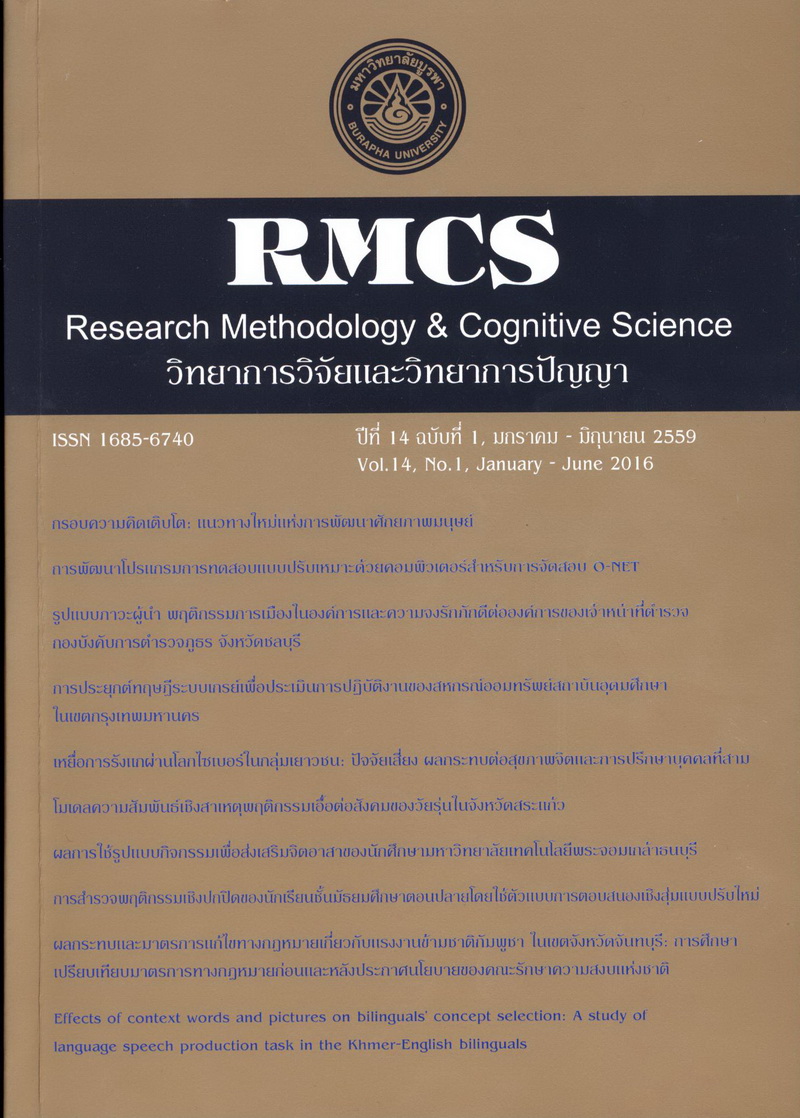Effects of context words and pictures on bilinguals’ concept selection: A study of language speech production task in the Khmer-English bilinguals
Main Article Content
Abstract
การวิจัยนี้มีวัตถุประสงค์เพื่อ 1) ศึกษาผลของตัวลวงที่เป็นค าและรูปภาพที่มีต่อการเรียนรู้ภาษาของ
บุคคลสองภาษา และ 2) เปรียบเทียบแหล่งข้อมูลที่ใช้ในการเรียนรู้ภาษาระหว่างกลุ่มที่มีความสามารถสูงกับกลุ่มที่
มีความสามารถต่ า กลุ่มตัวอย่างประกอบด้วยกลุ่มที่มีความสามารถสูงจ านวน 24 คน และกลุ่มที่มีความสามารถต่ า
จ านวน 24 คน โดยแบ่งระดับความสามารถด้วยผลการทดสอบที่ได้จากแบบทดสอบความสามารถทางด้านภาษา
ของ Gollan, Montoya and Werner (2002) การทดลองมีชื่อว่า Language speech production ด าเนินการ
โดยให้ผู้เข้าร่วมการวิจัยแปลค าศัพท์จากภาษาอังกฤษเป็นภาษาเขมร ค าศัพท์ที่ก าหนดให้มีบริบทของตัวลวงเป็น
ค าหรือรูปภาพ ตัวลวงที่เป็นค าและรูปภาพนั้น มีทั้งที่มีและไม่มีความหมายสัมพันธ์กับค าศัพท์ที่ก าหนดให้ ระหว่าง
การทดลอง ผู้วิจัยบันทึกเวลาการตอบสนอง และความถูกต้องของค าตอบ โดยใช้โปรแกรม DMDX วิเคราะห์ข้อมูล
ด้วยค่าเฉลี่ย ส่วนเบี่ยงเบนมาตรฐาน และ three-way ANOVA
ผลการวิจัยปรากฏว่า ผู้เข้าร่วมการวิจัยสามารถใช้เวลาการตอบสนอง ในบริบทของตัวลวงที่เป็นค าศัพท์
ได้เร็วกว่าตัวลวงที่เป็นรูปภาพ นอกจากนี้พบว่าตัวลวงที่เป็นค าซึ่งมีความหมายสัมพันธ์กับค าศัพท์ที่ก าหนดให้ส่งผล
รบกวนการเรียนรู้ภาษา ขณะที่ตัวลวงรูปภาพที่มีความสัมพันธ์กับค าศัพท์ที่ก าหนดให้ช่วยส่งเสริมการเรียนรู้ภาษา
กลุ่มที่มีความสามารถต่ าถูกรบกวนจากตัวลวงที่เป็นค าซึ่งมีความหมายสัมพันธ์กับค าศัพท์ที่ก าหนดให้มากกว่ากลุ่มที่มี
ความสามารถสูง และพบว่าตัวลวงรูปภาพที่มีความสัมพันธ์กับค าศัพท์ที่ก าหนดให้ช่วยส่งเสริมการเรียนรู้ภาษาใน
กลุ่มที่มีความสามารถต่ าได้น้อยกว่ากลุ่มที่มีความสามารถสูง ดังนั้นบุคคลสองภาษาที่มีความสามารถต่ า ควรเรียนรู้
ค าศัพท์ใหม่ในภาษาที่สองด้วยการคิดเชื่อมโยงกับค าศัพท์ในภาษาที่หนึ่ง (เช่น เรียนรู้ภาษาอังกฤษโดยเชื่อมโยงกับ
ภาษาเขมรที่เคยเรียนรู้มาก่อน) ในขณะที่บุคคลสองภาษาที่มีความสามารถสูงสามารถเรียนรู้ค าศัพท์ใหม่ในภาษา
ที่สองได้โดยตรง (เช่น เรียนรู้ค าศัพท์ภาษาอังกฤษจากรูปภาพที่มีความหมายสัมพันธ์กับค าศัพท์นั้น)
The purposes of this study were (1) to find out the effects of context word and picture
distracters on bilinguals’ language speech productions and (2) to compare the locus of concept
selections of less-proficient and high-proficient bilinguals. There were 24 participants in both
less-proficient and high-proficient groups categorized by the language production test of Gollan,
Montoya and Werner (2002). The experiment was known as language speech production where
individual subject was required to translate the presenting target word from English (L2) into
Khmer (L1) under semantically related and unrelated context picture and word distracters. The
reaction times (RTs) and accuracy were recorded using DMDX software. The data were
analyzed by mean, standard deviation and three-way ANOVA.
The reaction times of language speech productions under context word distracters
were faster than those of context picture distracters. Semantically related context words caused
semantic interferences while semantically related context pictures increased semantic
facilitations. Less-proficient bilinguals were more interfered by semantically related context
word distracters than high-proficient bilinguals. Less-proficient bilinguals were less facilitated
by semantically related context picture distracters than high-proficient bilinguals. In conclusion,
the locus of concept selections of less-proficient bilinguals was at the lexical level where they
needed to rely on lexical link from L1 in their language speech production. The locus of concept
selections of high-proficient bilinguals, on the other hand, was at the conceptual level where
they could directly conceptualize from semantically related context pictures.
Article Details
References
ASEAN. (2008). The ASEAN Charter. Jakarta: Association of Southeast Asian Nations.
Bloem, I., & La Heij, W. (2003). Semantic facilitation and semantic interference in word
translation: Implications for models of lexical access in language production. Journal of
Memory and Language, 48, 468-488.
Forster, K. I., & Forster, J. C. (2003). DMDX: A windows display program with millisecond
accuracy. Behavior Research Methods, Instruments, & Computers, 35, 116-124.
Gollan, T. H., Montoya, R. I., & Werner, G. A. (2002). Semantic and letter fluency in Spanish-English bilinguals. Neuropsychology, 16(4), 562-576.
Green, D. W. (1998). Mental control of the bilingual lexico-semantic system. Bilingualism:
Language and Cognition, 1, 67-81.
Kroll, J., & Stewart, E. (1994). Category interference in translation and picture naming: Evidence
for asymmetric connections between bilingual memory representations. Journal of
Memory and Language, 33, 149-174.
Poulisse, N., & Bongaerts, T. (1994). First language use in second language production. Applied
Linguistics, 15, 36-57.
Schwieter, J. W., & Sunderman, G. (2008). Language switching in bilingual speech production:
In search of the language-specific selection mechanism. The Mental Lexicon, 3(2),
-238.
Snodgrass, J. G., & Vanderwart, M. (1980). A standardized set of 260 pictures: Norms for name
agreement, image agreement, familiarity, and visual complexity. Journal of
Experimental Psychology: Human Learning and Memory, 6, 174-215.

